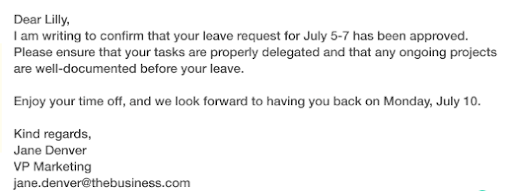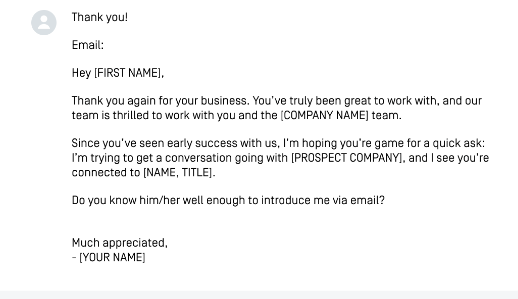
Every email has several components, including the subject line, greeting, body, and closing. While many people concentrate on the body of their message, you don’t want to ignore the other elements. Instead, give your message the best chance of being read from top to bottom by devoting attention to every factor, including your email sign-off.
Choosing an email sign-off that aligns with your message tone and intent helps readers connect with you. Those few final words in your message can convey friendliness, appreciation, urgency, or any other feeling. While your email sign-off may be short, it’s not something you want to overlook.
Most email sign-offs fall between one and five words, appearing just before your name and contact details. A few standard email sign-off examples include “Best,” “Kind regards,” and “Thank you,” although there are hundreds of options to choose from that can further personalize your message.
What is the importance of a proper email sign-off?
So, why is paying attention to your email sign-off so important? Well, you want to leave your reader with a positive impression in your closing message. Including a sign-off indicates the end of your email and conveys its final tone.
It’s essential to consider your audience and your message content when deciding on an email sign-off. An informal sign-off like “Catch you later” might be okay in an email to a close friend or family member, but if you’re sending a professional email or a marketing message, a you’ll want to create a sign-off that helps reinforce the goal of your email or email campaign.
Factors to think about when deciding on an email sign-off include:
- Whether you expect a response
- If you want the recipient to take additional action
- If you wish to express a feeling, such as sincerity, apologies, or appreciation
If your email is marketing or sales-related, you’re likely hoping to get a response from the reader. Selecting an email sign-off that encourages them to take the next step — like scheduling an appointment, visiting your website, or simply replying — can boost your response rates.
Different types of email sign-offs
There are all kinds of good email sign-offs you can use for any situation. Browse email templates for inspiration and use this list to inform your next email sign-off.
Professional email sign-offs
Emails sent professionally, such as to your boss, an executive, or a professor, call for a formal sign-off. Here are a few examples.
- Regards: A simple “regards” or a variation like “best regards” or “kind regards” is a positive way to end your message while staying within professional boundaries.

- Best: A sign-off like “best” or “best wishes” tells the reader you wish them well in a formal context.
- Sincerely: While sincerely isn’t as commonly used as 20 or 30 years ago, it’s an easy way to end professional communication — especially if you’re unfamiliar with the recipient.
- Respectfully: This sign-off is appropriate when deferring to someone else, such as a supervisor or professor. It tells them you recognize their expertise.
- With gratitude: You can use this sign-off when sending a professional message conveying appreciation for someone’s actions or feedback.
Work-friendly email sign-offs
Of course, not every message you send in the workplace will go to an executive. You can dial down the formality with colleagues using these email sign-offs.
- Cheers: This simple, friendly email sign-off is appropriate for most casual, work-related emails.
- Take care: It’s an easygoing email sign-off that conveys your positive relationship with the reader.
- Thank you: Telling the reader you appreciate their help or actions with a simple “thank you” is appropriate in most work contexts.
- All the best: Using “all the best” in a message to a coworker expresses your well wishes.
Funny email sign-offs
A funny email sign-off can brighten someone’s day and elicit some laughter. However, before using a humourous sign-off, ensure it fits the context of your message and your relationship with the recipient.
- Go Sooners!: Do you and the recipient share a favorite sports team? Show your support for the upcoming big game with a sports-related email sign-off.
- May the stars align: Are you hoping to close a big client deal, get a promotion, or get a low-interest rate on your mortgage? Use this sign-off with someone who shares your aspirations or wants the best for you.
- Movie quotes: Including a well-known movie quote in your email sign-off works with someone who shares your cinematic tastes.
Creative email sign-offs
Creative email sign-offs give your message an extra flair that holds the recipient’s attention and demonstrates your personality. Here are a few fun options.
- TGIF: Everyone loves a Friday — the start of a relaxing and enjoyable weekend.
- Let me know if you want to know more about XYZ: If you’re hoping to make a sale, close a deal, or something similar, this sign-off tells the reader you’re ready to answer any questions they have without being too salesy.
- Hope your Monday goes by without a hitch: Mondays signal the new beginning of a workweek, but you can wish your reader well with this simple closing.
Warm email sign-offs
If you have a strong relationship with your recipient, there’s no reason to use overly formal email sign-offs. Instead, try one of these options:
- Stay awesome: Whether you’re building a relationship or expressing gratitude for a well-established one, a positive email sign-off like “stay awesome” conveys your respect for the person.
- You’re an inspiration: Don’t overuse this one, but consider including it when someone goes the extra mile to help you.
- Warmly: This is a simple, approachable signoff that works for nearly any email communication.
Complimentary email sign-offs
A complimentary email sign-off works when the reader does something above and beyond, and you want to share your appreciation.
- Much appreciated: This is a little more casual than “with gratitude” or “thank you.” It’s appropriate with colleagues, customers, and close friends alike.

- Thank you for your time: This sign-off shows you acknowledge the reader’s time. You can add some personalization by specifying what they helped you with.
- You’re the best: This sign-off shows the reader how much you appreciate their efforts with this sign-off.
Casual email sign-offs
Are you emailing a friend, relative, or your bestie? Try one of these casual email sign-offs:
- Let’s chat about this: This tells the reader you want to continue the conversation in person or over the phone.
- Sending you good vibes: Best for friendly emails with a close contact.
- Talk soon: If you plan on seeing the recipient in person shortly, this sign-off is a good reminder while keeping things casual.
Email sign-offs for different occasions
Sometimes, you’ll want a unique email sign-off for a specific occasion. Here are some examples.
Apologies
- I’m so sorry
- Sorry for your loss
- With apologies
- That’s my mistake
- Sorry
Appreciation
- Thanks so much
- I appreciate your help
- Your help is invaluable
- You’re a rock star!
Condolences
- Thinking of you
- My sympathies
- Let me know if you need anything
- My sincere condolences
Holidays
- Happy holidays!
- All the best this holiday season
- Wishing you a wonderful holiday
- Happy New Year
Vacation
- Enjoy your break!
- Have a wonderful trip!
- Have a great time
- Enjoy your vacation

Bad news
- Let’s work this out together
- I’m here to help
- Call me whenever you like
- Don’t hesitate to reach out if you want to talk
Job application
- I appreciate your consideration
- I look forward to meeting you
- Best regards
- Thank you
How context matters: Generational and cultural differences
Older generations (think Gen X, Baby Boomers, and some Millenials) may expect more formality in email sign-offs — especially in the workplace. So, if you’re emailing your supervisor or an executive, they may expect more formality from you, especially if they’re part of an older generation.
Conversely, Gen Z and younger Millennials may find traditional email sign-offs like “best regards” or “sincerely” too dull or stuffy. If you receive an overly casual email sign-off from a young Gen Z’er, don’t assume it’s disrespectful; they may not share the same beliefs about email etiquette as you do.
It’s also crucial to consider cultural differences among your recipients. As workplaces extend their overseas presence and people immigrate from countries abroad, you may find certain sign-offs don’t work. For instance, wishing someone a Merry Christmas is inappropriate for a reader with a different faith. If you’re sending a message in a foreign language, use the proper translation to avoid any awkwardness.
Common email sign-off mistakes and how to avoid making them
A few email sign-offs can come across as annoying or passive-aggressive. Use them sparingly, if at all, and carefully consider the relationship with the recipient and the message tone.
Here are some questionable sign-offs that your reader might not appreciate:
- Very truly yours: It may seem inauthentic or overly formal.
- Thanks in advance: Tells the reader you expect quick action, regardless of their time constraints.
- Take it easy: Very informal and inappropriate for the workplace.
Difference between email sign-offs and email signature
Your email sign-off comes just before your email signature. The email sign-off signifies the end of your message, while your signature includes your name and contact information.
If you’re sending an email for sales or marketing purposes, include all the information the recipient needs to learn more about what you have to offer. List your phone number, company name, email address, and a link to your business website. You can also include social media links to platforms you use, like LinkedIn, Facebook, or Instagram.
The more details you include, the less reconnaissance your reader has to do to learn more about you. Having everything in one place allows them to click, call, or contact you in the way that’s most convenient for them.
Now, if you’re emailing someone in a non-professional setting, such as a friend or relative, all that information isn’t necessary and may be over the top. Instead, just include your name.
Tips and techniques for memorable email sign-offs
So, how do you make the most of the short space between your message and email signature? If you want to take every opportunity to encourage a response or action, personalize your email sign-off. Personalization makes your email memorable, but be careful not to cross any boundaries. So, including a movie quote might be okay with a friend, but it probably wouldn’t go over well for a job opportunity.
The key is considering three critical aspects of your email: message content, tone, and relationship with the recipient. A well-chosen email sign-off will align with all three elements.
Frequently asked questions on email sign-offs
Here are some answers to typical questions our readers have about the best email sign-offs.
What is a nice email sign-off?
Some email sign-offs that convey a friendly tone include “All the best,” “Kind regards,” and “Best wishes.”
How does Gen Z sign off emails?
Gen Z takes a more informal approach to email sign-offs, especially when casually messaging. However, they may stick with traditional email sign-offs in work settings.
How do you end a friendly email?
To end your email on a positive note, try a sign-off like “Talk soon,” “Cheers,” or “Enjoy your day!”
How do you sign off an email warmly?
To convey a warm relationship with an email recipient, try a sign-off such as “Always a pleasure,” or “Take care.”
Email sign-offs: Context and relationship are key
There are so many email sign-offs that it can be a real challenge to settle on the appropriate one to close your message. To get it right every time, consider the purpose of your email and the relationship with your reader. In other words, a formal message should have a formal email sign-off, a marketing email sign-off should be consistent with your brand’s voice and mission, and a casual message exchange with a friend should be personalized. Above all, make the most of your emails by paying attention to every element — even the last few words before your signature!
Need more tips on the ins and outs of email? Check out these guides:




